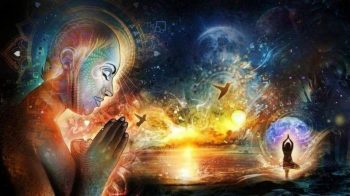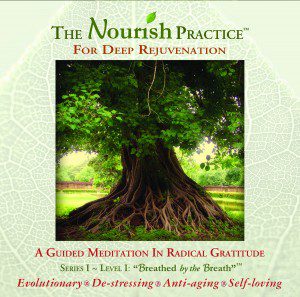Contributing writer for Wake Up World
“Where the light is brightest, the shadows are deepest.” ~ Goethe
When we invoke light, we automatically invoke darkness, and vice versa. Each is necessarily contrasted and thereby defined by the other. Ironically, however, the mention of light and dark is often considered dualistic. Yet not to consider both is to negate reality, as if we could describe a whole day as only when the sun is out and ignore the night. Or to discuss marriage and speak only of one partner. So, day and night, masculine and feminine, life and death, pain and pleasure, when integrated in the ways we will explore shortly, represent wholeness and non-dualism.
Dark and light, as Yin and Yang, respectively, are the two all-inclusive universal metaphors eternally cooperating with one another to represent the whole of nature and cosmos. When light is discussed without allusion to darkness, dualism and a fractioned wholeness are invoked. What are the consequences of ignoring the reality of light’s other half and its effects on our well-being, our survival, and what many too literally and shortsightedly refer to as our “spirituality?”
Because a unilaterally light-oriented spirituality does not embrace the dark, it is unsustainable. Let us consider, then, the surprising possibility that a primarily light-oriented spirituality is one whose “shadows are the deepest”—a fear-based reaction to, the disguised projection—resulting from not entering and being transformed by our psychological pains, our proverbial darkness. As with any shadow, we have to dig beneath the surface to reveal it. Once we project our spirituality into the ethers we have to return that much further back into our bodies to uncover its shadow roots. This, incidentally, brings to mind the image of the island on which I live—it is said to be the tallest mountain in the world, when we consider not just height above “see level,” but how far under water its base extends. Whatever “light” we project into the world, it’s crucial that it be connected, integrated with our depths. This integration happens via the transformation of our shadow nature. Otherwise, too many of our actions will be fractioned, unhealthy, short-sighted, and violent. And many wonder why humans are so uncaring, greedy, and harmful?
Our dark sides harbor the hidden wounds left over from childhood and later traumas that we often drag around our entire lives. They are buried in our emotional midbrains (amygdala and hippocampus, primarily), beneath the immediate awareness of our conscious forebrains, (neocortex), the latter employed primarily for an experience of conscious awareness. Integration of dark and light through the lens of neurobiology can therefore be seen as the integration of our “light” conscious minds (neocortex) with the darker, unconscious regions of our midbrains, and even further into the instinctive faculties of our “reptilian” lower brain regions. This is integrated, body-centered, reality-based spirituality centered around becoming conscious of our past emotional past traumas, which then allows us to heal these places in order to live more fulfilling, caring, passionate lives.
Our emotional wounds cause us to abandon intimacy with our bodies and project our imagination of wellness and empathy into the heavens and “invisible realms,” into “mystery.” Yet this mystery is more often a euphemism, a projection, for the inner confusion we experience with our core, unhealed pains. This way, new-age “spirituality” becomes a shadow for grounded psychology. When we deal with our psychology, our embodied experience of ordinary life and love, we reclaim a functional, sustainable spirituality that does not need to leave our bodies behind to experience tremendous beauty, awe, reverence, bliss, wildness, passion, creativity, and lightness. And to fully experience sensuality, intimacy, compassion, love, desire, and fulfillment, our whole bodies, our whole selves, must be present! Yet so few of us go into these dark reaches, so to pass through and be transformed by them into wholeness, that much of this juicy goodness that we do not associate with embracing darkness is lumped into an imagination of fantastic, unproven beliefs that produce fractioned actions lacking in integrity.
These core wounds sabotage our intimacy and passion, our relationships and felt-sense of meaning, our joy and service to the world. They show up as our unconscious fears and self-sabotaging, our knee jerk reactions, our apathy, chronic unreasonable anger, addictions, depression, loneliness, and disenchantment. And they manifest in humanity’s disjointed, unsustainable enterprises that do more harm than good—the creation and using of nuclear weapons and toxic pesticides, the hoarding of resources so that millions go hungry, the exploitation of defenseless people and wholesale destruction of beautiful ecosystems in the name of progress, as examples.
Our dark, unhealed interiors, however, are only a negative force when we do not reckon with them, when we do not enter and transform their orphaned aspects into functional, vital aspects or ourselves. These paralyzed hurts remain dark until we drop our awareness into our bodies, sink into our deep hearts, and re-experience these traumas and injustices. Let us therefore consider shadow work—as in dealing with our backlogged emotional wounds—to be the sustainable antidote, the reasonable substitute, to the current-day malady of ungrounded, unrealistic, magical thinking new-age spirituality and unsustainable progress.
A comprehensive processing of our historical wounds is best undertaken in psychotherapy, with a somatic or body-centered practitioner. But we can begin the process on our own merely by acknowledging and more deeply feeling into life’s challenges. Shadow work is one of the most crucial investments we can make to liberate our lives from the grips of numbness, pain, and feeling purposeless, as well grow the welfare of our planet, even if we have not or don’t think we have suffered overt, major trauma.
Shadow work is also an appetizer for entering the dark night of soul, in which we die to all that has failed and alienated us from ourselves, so to be reborn from the depths of our bodies. If we do not embrace—and thereby deny and ignore—our shadow selves, we end up preserving an “infertile darkness,” which we then witness outwardly in our many unsustainable modern-day enterprises. Descent into and dissolution of these ostracized stagnations is a fundamental cure for the artifices we have become and created in turning from the dark.
Fertilizing the Dark
When we suffer a trauma or a significant hurt our psyche shuts down, contracts and recoils, as a way to protect ourselves. It is the emotional correlate to a physical recoiling. Physical and emotional trauma are almost always accompanied by contraction, and their healing involves “opening up” and letting go—metaphors that reflect actual physiological and anatomical shifts.
Say, for example, you were attacked by a mountain lion, during which your life was at stake. You end up with bruises, bleeding, and bones out of place that cause constriction of muscles, tendons, and other tissues, all of which exacerbates the contraction of muscles instinctually engaged during the attack. Healing from this attack would involve “unwinding” or letting go of the physical and emotional tension-contraction patterns suffered from the attack. The contracted, injured physical and emotional aspects of the trauma represent a consolidation, an isolation of pain from wellness. If wellness is our light, then the trauma can be described as a darkness.
This trauma begins a process of dissociation, of pain from pleasure, creating a duality of light and dark inside us. It begins the consolidating of infertile darkness from the recycling, harmonious, co-creative circuitry of dark and light flowing harmoniously inside us into the world and back through us again. . It creates stagnation and eventually disintegration, as it erodes our comfort in our own skin, our ability to access all of our inner resources, and to act from integrity. If left unreckoned-with, our traumas create an infertile darkness, which continues to create more disharmony and suffering for us and those we touch. The cure is to find pleasure from the pain, which means going through the hurt, as the trauma and its associated difficult emotions and feelings transform us in the process.
Since we all suffer significant hurts and loss in one form or another throughout our lives, grief and reconciling our hurts is a lifetime process. The bigger issue, however, is that most of us don’t learn how to process and heal the wounds we suffer until sometime later in adulthood. Therefore, when we actually realize how to do this work, which I refer to here as shadow work or dark work, we have a backlog of hurts to deal with. It is this backlog I refer to when I speak of our “backlogged pain,” past heartaches and traumas, or our wounds from childhood.
In doing the dark work we do not vanquish it, but merely make it conscious so that its power and resources can be an ally to our outgoing light-work, our sharing of goodness. Carl Jung, an authority on the psyche, said that, “One does not become enlightened by imagining figures of light, but by making the darkness conscious.” Integration and wholeness (if I may use these terms to convey an embodied sense of enlightenment) arrive from acknowledging and transforming the dark or painful patternings in our bodies. Dr. Jung is also saying that to become “enlightened” we need not focus so much on the light, but on the dark, become conscious of it, and thereby rejoin dark and light inside ourselves into a functional, vital relationship. This gives light the wisdom of our depths, and darkness the awareness of our minds, joining the light and dark portions of our brains and associated lower body regions.
After all, it makes little sense to integrate light and dark by applying darkness to light; this in fact, is the very scenario in need of healing, as it represents the collective cruelty and pollution of our world. We must bring light to the dark places, and it is this “dark work” that creates an enduring, balanced, and prodcutive “light” of enlightenment. This poem of mine communicates the point.
Love Affair
I’ve been accused of having a love affair
With death and darkness.
It’s true.
Yet I cherish and live for the light;
It’s just that I found it in the dark.
After all, how many light-graspers can say
They also adore the darkness?
Beholden to dark and light
Yin and Yang are forever married
In my heart.
We can convert an infertile, diminishing darkness into a creative, fecund one—able to heal and be healed—by “fertilizing” it with the light of our awareness and the unconditional love of self-compassionately abiding through our re-experiencing of pain. When we re-feel the backlogged hurt in our bodies and make sense of our pain, we can reclaim our vitality and a felt-sense of our life’s meaning and purpose—our full hearts, our embodied enlightenment, our soulfulness. We develop healthier ways to love ourselves and one another. When we do not address our hurts, we act out the unconscious violence and hurt that we have not transformed and been transformed by. To do the inner dark work, then, is to figuratively establish light inside ourselves—by compassionately clearing the heartaches that numb, fraction, and leave us creatively infertile.
The light we establish through this grounded process is not fancy, not a temporary effect, because we comprehensively change the very wiring of our nervous systems, the specific neurobiology and physiology of which is complex, and to my understanding, not yet fully understood. Yet, we can still engage the transformational process. Rewiring our brains for new responses is a permanent clearing of our backlogged pain, which we can maintain relatively clear so long as we continue to houseclean our hearts. This means we tend to its incursions into darkness, feel our feelings (be emotionally honest), process our hurts, think critically and reasonably, and act with integrity. When we actualize this foundational transformation of cumulative darkness into light, we create a rich inner (and outer) life that become a warm hearth, a home and trusted guide to navigate life’s many undertakings and transitions. When we transform our own darkness into the light of a clear and resourceful body-mind, we no longer need to imagine light, conjure it, grasp for it, magical think it, because, in effect, we have become it via our newfound clarity and inner spaciousness. We live with it in our bodies and get to enjoy its constant stream of inspiration, creativity, intelligence, and appreciation for goodness and ordinary beauty.
While doing the dark work we therefore might find ourselves effortlessly letting go of new-age fantasy spirituality. This can occur because we are now integrating inside ourselves the magic, positivity, promise, and feel-good we at one time had to fantasize to try to experience. When we reclaim our light and love via shadow work we begin to produce these experiences as a function of our newfound integrity. We may also discover that our unrealistic, shadow belief systems actually impede our integral healing work because they were specifically, though likely unconsciously, adopted to deny our pains, which we are now discovering to be not hindrances to our spirituality, but doorways.
As an analogy, consider a computer printer. When the printer is set at low quality, its internal machinery does not need to be so precise and well calibrated to produce the low-quality image, and the printing process is quick. This represents our lives in pain. Yet if we choose a high quality image, a more detailed calibration and synthesis are needed to produce it, and the printing process is slower. This is our life resulting from the patient, steady, detailed work of deep emotional healing. A body-mind that does not do the deep integration work more consistently produces and acts with low-integrity. Whereas, an integrated interior life more consistently produces and acts with integrity.
Prior to shadow work we are only capable of producing low quality images; after integrating the dark, we are more finely calibrated and less internally “dusty” and “gooey” and contracted and more able to produce higher quality prints. We now have the internal “machinery” to offer something beautiful to the world. We become higher calibrated (by going down into ourselves) and smoother operating spiritual organisms!
The antidote, then, to a fantastic, ungrounded, new-age spirituality—a la Jung’s “imagining figures of light”—is to enact the transformation of backlogged pain into pleasure by way of our own abiding compassion and courage to acknowledge and love ourselves through a hands-on process of re-experiencing and thereby releasing this pain, while simultaneously learning new ways to care for ourselves and others. The latter alone is not enough because the foundation of pain in our bodies, as recorded by so many neurons primarily in our emotionally-oriented midbrains, does not just go away on its own anymore than we can magically lay down at will new neuronal connections to code for new learning and responses. If we want to live and give the most of ourselves, we have to clear out (heal) our depths, which requires this deep work.
Our neurally recorded and constantly reactivated pain does not clear until we go into and release it. This happens via the neurobiological process of “neurons that fire together wire together.” We need to re-experience the pain (get the painful memory neurons firing) so that the new learning (simultaneously loving behavior and compassion) can be wired to it, thus connecting pleasure and feel-good love to pain in order to change our perceptions, experience, and future responses—otherwise known as transformation and healing! In addition to feeling this pain, we also need to recognize, to remember, to learn about what happened to us once upon a time. This way, the cognitive part of our brains (neocortex) engages in the process of our emotional brains (midbrain) and its associated physiological responses. This further consolidates mind-body integration (more deeply and comprehensively than yoga and traditional meditation can effect, though can be aided by them) and a sustainable, functional re-learning of love.
Many avoid or simply do not know how to identify and heal emotional wounds, and therefore, do not get to experience the same kind of fulfillment from ordinary joy and pleasure. In this sense, shadow work is an initiation into fulfillment by simplicity, which extends to decreasing our environmental footprint. Let’s face it, most forms of entertainment for superficial fun also consume lots of natural resources and create lots of waste. Sometimes I call this “consumerism fun.” In my poem “Sacred” I attribute this wastefulness to being “addicted to entertainment.”
Shadow work (sacred body work) can help to improve the world as we know it not only by decreasing our need for so much entertainment/distraction but also because it transforms us into deeply empathic and compassionate people. First-hand experience with our wound-healing engrains compassion and empathy into our hearts over long periods, as well as reminds us every day we sit with our pain the importance of being mindful for how our beliefs, choices, and actions affect one another.
On a related note, it is one thing to do what we consider fun and enjoyable and another to actually feel joy from it. When we clear out our unconscious emotional stagnations we end up with more functional physiology and anatomy with which to actually feel joy and pleasure and to appreciate beauty. Because shadow work is comprehensive, it means that we also may become more drawn to activities (or more so engage in existing ones), that bring us deeper pleasure and satisfaction. We may pick up a passion we haven’t made time for, such as medicine, gardening, exercise, of environmental work, spending time in nature and with children, or more time at a particular calling which feels like our reason for being alive. As indeed, comprehensive shadow work often clarifies our life purpose as well.
Part II can be read here
The Nourish Practice
Jack Adam Weber’s “The Nourish Practice” is an easy, guided meditation-Qi Gong practice in radical gratitude and self-love. It is an Earth-based, body-centered practice — at once physiological and mythological — that is deeply relaxing and replenishing, especially for modern-day burn-out syndrome, and requires little physical effort.
The Nourish Practice “resets your nervous system” and fosters a rich inner life. You can purchase The Nourish Practice as a CD or Digital Download here.
Previous articles by Jack Adam Weber:
- Relationships: The Costs of Staying When We Should Leave
- Sex, Love and Attachment
- Emotional Work
- Choosing a Partner – How to Avoid Relationship Suicide
- Re-Thinking Love: Why Our Hearts Must Also Be Minded
- Spirituality – Reality Check
- 11 Crucial Tips for Better Digestive Health
- Shadow Work: Becoming a Sustainable Light Worker (Part 1)
- Oneness in Action: The GMO Eradication Movement
- After the Hurricane: Lessons from the Heart of Nature
- Relationships: How They Can Make Us Happier
- Heartbreak – Loving Ourselves Through Difficult Times
About the author:
 Jack Adam Weber, L.Ac. is a Chinese medicine physician, author, celebrated poet, organic farmer, and activist for body-centered spirituality. His books, artwork, and provocative poems can be found at his website PoeticHealing.com. He is also the creator of The Nourish Practice, an Earth-based rejuvenation meditation. Weber is available by phone for medical consultations and life-coaching.
Jack Adam Weber, L.Ac. is a Chinese medicine physician, author, celebrated poet, organic farmer, and activist for body-centered spirituality. His books, artwork, and provocative poems can be found at his website PoeticHealing.com. He is also the creator of The Nourish Practice, an Earth-based rejuvenation meditation. Weber is available by phone for medical consultations and life-coaching.
You can connect with Jack Adam Weber on Facebook or by emailing [email protected].

If you've ever found value in our articles, we'd greatly appreciate your support by purchasing Mindful Meditation Techniques for Kids - A Practical Guide for Adults to Empower Kids with the Gift of Inner Peace and Resilience for Life.
In the spirit of mindfulness, we encourage you to choose the paperback version. Delve into its pages away from screen glare and notifications, allowing yourself to fully immerse in the transformative practices within. The physical book enriches the learning process and serves as a tangible commitment to mindfulness, easily shared among family and friends.
Over the past few years, Wake Up World has faced significant online censorship, impacting our financial ability to stay online. Instead of soliciting donations, we're exploring win-win solutions with our readers to remain financially viable. Moving into book publishing, we hope to secure ongoing funds to continue our mission. With over 8,500 articles published in the past 13 years, we are committed to keeping our content free and accessible to everyone, without resorting to a paywall.








